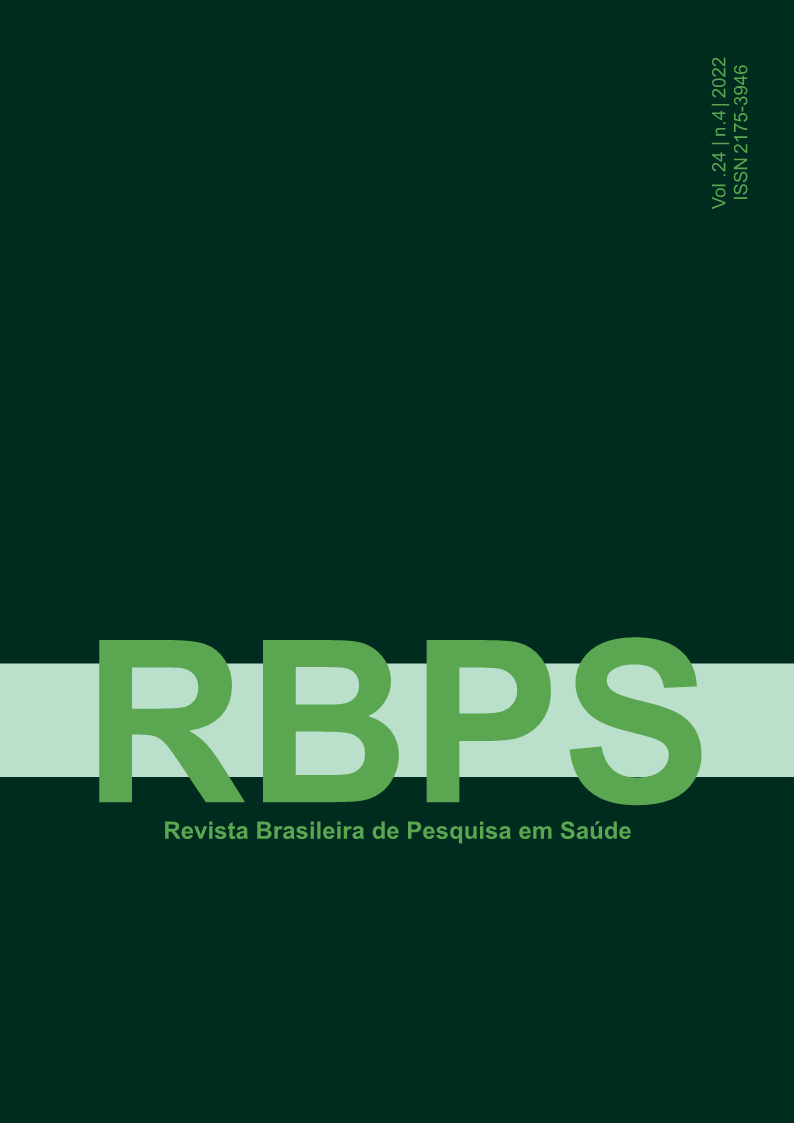Scenario of public policies for the elimination of leprosy with the advent of the Covid-19 pandemic
Scenario of public policies for the elimination of leprosy with the advent of the Covid-19 pandemic
DOI:
https://doi.org/10.47456/rbps.v24i4.39167Keywords:
Leprosy, Public Health, Epidemiology, Covid-19Abstract
Introduction:
Brazil is the second country in the world with the highest number of new leprosy cases. Objective: To verify the progress towards the elimination of Leprosy in Brazil, State of São Paulo and region of the Regional Department of Health XV through the analysis of three leprosy indicators over 10 years, including the period of Covid-19. Methods: Data were collected from Ministry of Health websites from 2011 to 2021. The indicators analyzed were: Annual detection rate of new leprosy cases/100,000/inhabitant; Annual detection rate of new leprosy cases, in the population under 15 years old/100,000/inhabitants; Proportion of leprosy cases with degree 2 of physical disability (GIF2) at the time of diagnosis among new cases detected and evaluated in the year. Results: In Brazil and in ESP, although in decline, overall detection remained in the “medium” parameter and general detection in children under 15 years of age in the “low” parameter in ESP and “medium” in Brazil. In the DRS XV region, the same indicators fluctuated in the period in the parameters “high” and “medium” respectively. The GIF 2 indicator was on the rise in the three regions studied, including during the Covid-19 pandemic. Conclusion: The study points to the need for additional strategies to achieve the desirable results of timely detection, cure and containment of physical disabilities and sequelae. The negative effect of the pandemic on leprosy diagnosis is evident and raises concerns about the ability to achieve leprosy control goals in Brazil.
Downloads
References
Ribeiro MD, Silva JC, Oliveira S. Estudo epidemiológico da hanseníase no Brasil: reflexão sobre as metas de eliminação. Rev Pan-American Salud Públ. 2018;1-7. doi: https://doi.org/10.26633/RPSP.2018.42
WHO. World Health Organization. Estratégia global: 2021-2030: rumo à zero hanseníase. (2021). Disponívelem: https://www.jstor.org/stable/pdf/resrep38996.pdf?re-freqid=excelsior%3A56ce159d125e330a8e03ffb6fffd¬d735&ab_segments=&origin=&acceptTC=1
Weigelt LD, Mancio JG, Petry ES. Indicadores de saú¬de na visão dos gestores dos municípios no âmbito da 13ª Coordenadoria Regional de Saúde - RS. Barbaroi, San¬ta Cruz do Sul; jun 2012;36:191-205. Disponível em: http://pepsic.bvsalud.org/scielo.php?script=sci_arttext&pi¬d=S0104-65782012000100012&lng=pt&nrm=iso
David MS. O impacto do uso indiscriminado de antibióticos na pandemia da Covid-19. In Duarte AB, et al. Pandemia: caminhos para aprendizagem. São Carlos: Pedro & João Editores; 2021;11:165-74.
Senok A, Alfaresi M, Khansaheb H, Nassar R, Hachim M, Al Suwaidi H, et al. Co-infections in patients hospitalized with Covid-19: a descriptive study from the United Arab Emirates. Infect Drug Resist. 2021;14:2289- 96 doi: https://doi.org/10.2147/IDR.S314029
World Health Organization Health Emergency Dashboard - WHO. Covid-19 homepage [acesso 11 ago 2022]. Disponível em: https://covid19.who.int/
Pernambuco ML et al. Hanseníase no Brasil: ainda mais negligenciada em tempos de pandemia do Covid-19? Rev Saúde Públ. Paraná: mar 2022;5(1):2-18.
Martins-Melo FR, Ramos Jr. AN, Alencar CH, Heukelbach J. Mortality from neglected tropical diseases in Brazil, 2000-2011. Bull. World Heal Organ. 2016.
Brasil. Ministério da Saúde. Secretaria de Vigilância em Saúde. Departamento de Vigilância das Doenças Transmissíveis. Diretrizes para vigilância, atenção e eliminação da Hanseníase como problema de saúde pública: manual técnico-operacional [Internet]. Brasília: Ministério da Saúde; 2016 [acesso 12 abr 2019]. 58 p. Disponível em: http://www.saude.pr.gov.br/arquivos/File/ Manual_de_Diretrizes_Eliminacao_Hanseniase.pdf
Brasil. Ministério da Saúde (MS). Secretaria de Vigilância em Saúde. Departamento de Doenças de Condições Crônicas e Infecções Sexualmente Transmissíveis - DCCI. Boletim Epidemiológico de Hanseníase, 2021. [internet]. [acesso 9 jun 2022]. Disponível em: http:// www.aids.gov.br/pt-br/pub/2020/boletim-epidemiologico-de-hanseniase-2020
Brasil. Ministério da Saúde. Secretaria de Vigilância em Saúde. Vigilância de A a Z, hanseníase, situação epidemiológica: dados e resultados. Disponível em: http:// portalms.saude.gov.br/saude-de-a-z/hanseniase/situacao-epidemiologica
Brasil. Ministério da Saúde. Secretaria de Vigilância em Saúde. Departamento de Vigilância em Doenças Transmissíveis. Plano integrado de ações estratégicas de eliminação da hanseníase, filariose, esquistossomose e oncocercose como problema de saúde pública, tracoma como causa de cegueira e controle das geohelmintíases: plano de ação 2011-2015. Brasília, 2012.
Oliveira KS et al. Avaliação dos indicadores epidemiológicos e operacionais para a hanseníase em municípios prioritários no estado do Paraná, 2001 a 2010. Epidemiol Serv Saúde. Brasília: set 2015;24(3):507-16. Disponível em: http://scielo. iec.gov.br/scielo.php?script=sci_arttext&pid=S1679- 49742015000300016&lng=pt&nrm=iso
Brasil. Ministério da Saúde. Secretaria de Vigilância em Saúde, Departamento de Vigilância das Doenças Transmissíveis. Exercício de monitoramento da eliminação da hanseníase no Brasil - LEM-2012. Brasília: Ministério da Saúde; 2015.
Roncalli AG, Lima KC. Impacto do Programa Saúde da Família sobre indicadores de saúde da criança em municípios de grande porte da região Nordeste do Brasil. Ciênc Saúde Colet. Rio de Janeiro: set 2006 [acesso 30 mai 2019];11(3):713-24. doi: http://dx.doi.org/10.1590/ S1413-81232006000300018 Disponível em: http:// www.scielo.br/scielo.php?script=sci_arttext&pid=S1413- 81232006000300018&lng=en&nrm=iso
WHO. World Health Organization. Neglected tropical diseases: impact of Covid-19 and WHO’s response. Wkly Epidemiol Rec. 2020;95:461-8.
Matos TS et al. Impact of the Covid‐19 pandemic on the diagnosis of new leprosy cases in Northeastern Brazil, 2020. Intern J Dermatol. 2021;60(8):1003-6.
Paz WS et al. Impact of the Covid-19 pandemic on the diagnosis of leprosy in Brazil: an ecological and population-based study. Lancet Reg Heal: Americas, mai 2022;9:100181.
Silva JS et al. Atenção às pessoas com hanseníase frente à pandemia da Covid-19: uma revisão narrativa. Rev Eletr Acer Saúde. 2021;13(2). doi: https://doi.org/10.25248/ REAS.6124.2021
WHO. World Health Organization 2021. Global leprosy (Hansen disease) update: impact of Covid-19 on global leprosy control. 2021;96(36):421-44.
Lanza FM. Avaliação da atenção primária no controle da hanseníase: validação de instrumentos e análise do desempenho de municípios endêmicos do Estado de Minas Gerais [tese]. Belo Horizonte: Escola de Enfermagem da UFMG; 2014.
Tonelli NM, Batista Duo Filho V, Belotti NC, Patine FS, Araújo TM, Del´Arco Paschoal V, et al. O Papel da capacitação em saúde nos resultados da baciloscopia para hanseníase. RBCS [Internet]. 5 dez 2020 [citado 16 set 2022];24(4). Disponível em: https://periodicos.ufpb.br/ ojs2/index.php/rbcs/article/view/52131
Downloads
Published
How to Cite
Issue
Section
License
Copyright (c) 2023 Brazilian Journal of Health Research

This work is licensed under a Creative Commons Attribution-NonCommercial-NoDerivatives 4.0 International License.

